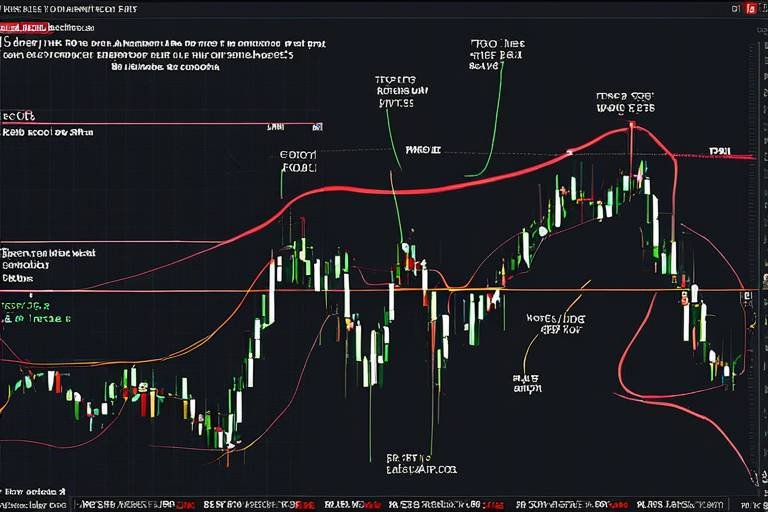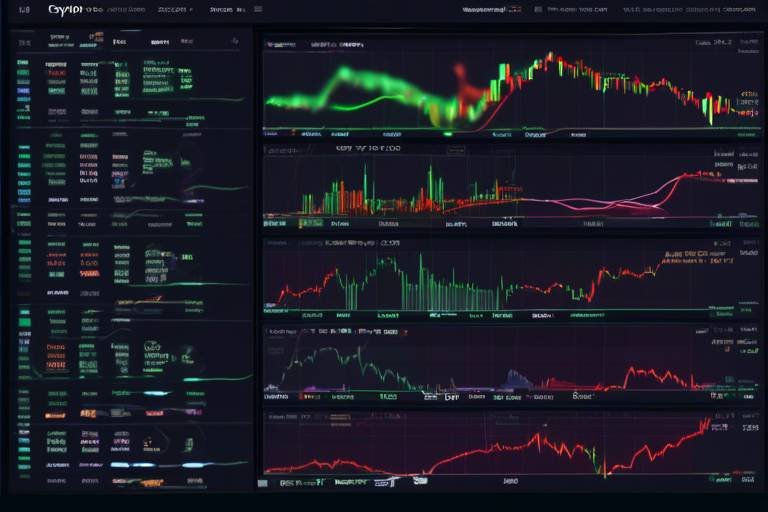How to Use RSI for Better Trading Decisions
The financial world can often feel like a rollercoaster ride, with prices soaring and plummeting in a matter of moments. As a trader, understanding the tools at your disposal can make all the difference between a thrilling ride and a disastrous fall. One such tool is the Relative Strength Index (RSI), a powerful momentum oscillator that can help you navigate the ups and downs of the market. By learning how to effectively utilize RSI, you can enhance your trading strategies and make more informed decisions that can lead to greater financial success.
So, what exactly is RSI? In simple terms, it measures the speed and change of price movements, providing insights into whether an asset is overbought or oversold. Imagine RSI as your personal market detective, helping you uncover hidden clues about price movements. With a scale ranging from 0 to 100, RSI offers a clear visual representation of market conditions. A reading above 70 typically indicates that an asset is overbought, while a reading below 30 suggests it may be oversold. By understanding these basic principles, you can start to see how RSI can be a game-changer in your trading journey.
Before diving deeper, let’s break down the RSI formula. The calculation involves comparing the average gains and average losses over a specified period, usually 14 days. The formula looks like this:
RSI 100 - (100 / (1 + RS)) Where: RS Average Gain / Average Loss
This formula might seem a bit daunting at first, but don’t worry! The beauty of RSI is that once it’s calculated, you can focus on interpreting the results rather than crunching the numbers yourself. Many trading platforms automatically compute RSI for you, allowing you to concentrate on making strategic decisions based on the data provided.
Now that we have a grasp on what RSI is and how it’s calculated, let's talk about interpreting those values. The significance of different RSI levels can be a trader's best friend. Common thresholds, such as 30 and 70, serve as critical indicators of market conditions. When the RSI crosses above 70, it signals that the asset is likely overbought, which can suggest a potential price correction. Conversely, an RSI reading below 30 indicates oversold conditions, hinting at a possible price rebound.
When you spot an RSI reading above 70, it’s like a red flag waving in the wind. This typically signifies that an asset is overbought. But how do you recognize these conditions in real-time? Traders often look for additional confirmation through price action or volume trends. For instance, if the price is making new highs but the RSI is failing to do so, it could be a sign that the upward momentum is waning. In such cases, you might want to consider employing strategies like short selling or taking profits to safeguard your investments.
Trading in overbought conditions can be risky, as the potential for a price correction looms. Imagine you're standing on the edge of a cliff; while the view might be beautiful, one wrong step could lead to a fall. Similarly, when an asset is overbought, it may experience a sharp decline. Understanding these risks is vital for any trader. You need to weigh the potential rewards against the risks. Sometimes, it’s wise to step back and reassess your strategy rather than diving headfirst into a trade.
When faced with overbought conditions, traders have several strategies at their disposal. Here are a few effective tactics:
- Short Selling: This involves borrowing shares to sell them at the current price, hoping to buy them back at a lower price later.
- Taking Profits: If you’ve had a successful trade, consider locking in your gains before a potential downturn.
- Setting Stop-Loss Orders: Protect your investments by placing stop-loss orders to automatically sell if the price drops to a certain level.
By implementing these strategies, you can manage your risk effectively while capitalizing on market opportunities.
On the flip side, an RSI reading below 30 indicates that an asset may be oversold. This is where the market can feel like a coiled spring, ready to bounce back. Identifying these conditions can present lucrative trading opportunities. When the market is oversold, it often leads to a price rebound, making it an attractive entry point for traders looking to buy low. However, it’s essential to confirm oversold signals with other indicators or analysis to avoid false signals.
While RSI is a powerful tool on its own, combining it with other technical indicators can significantly enhance your trading strategy. For example, using moving averages alongside RSI can provide clearer signals for entering and exiting trades. Moving averages smooth out price fluctuations, allowing you to see the overall trend more clearly. When both indicators align, it can strengthen your trading decisions and increase the likelihood of success.
Integrating moving averages with RSI can be particularly effective. For instance, if the RSI indicates an overbought condition while the price is above a moving average, it might be a good time to consider selling. Conversely, if the RSI shows oversold conditions and the price is below the moving average, it could signal a buying opportunity. This dual approach can provide a more comprehensive view of market dynamics.
Another powerful combination is using RSI with support and resistance levels. These levels act as psychological barriers where prices tend to reverse. By identifying these levels and monitoring RSI readings, traders can improve their trade timing. For example, if the price approaches a support level while the RSI is below 30, it could indicate a strong buying opportunity. Conversely, if the price nears a resistance level with an RSI above 70, it might be wise to consider selling.
What is the best time frame to use RSI?
The best time frame for RSI depends on your trading style. Day traders may prefer shorter time frames (like 5 or 15 minutes), while swing traders might opt for daily or weekly charts.
Is RSI a reliable indicator?
While RSI is a valuable tool, it’s essential to use it in conjunction with other indicators and analysis methods for the best results. No single indicator is foolproof.
Can RSI be used for all markets?
Yes, RSI can be applied to various markets, including stocks, forex, and commodities. It’s versatile and can be adapted to different trading strategies.

Understanding RSI Basics
The Relative Strength Index (RSI) is a powerful momentum oscillator that traders use to gauge the speed and change of price movements in the financial markets. Understanding the RSI is crucial because it helps traders identify potential reversal points, enhancing their trading strategies. The RSI is calculated using a specific formula that compares the magnitude of recent gains to recent losses over a specified period, typically 14 days. The result is a value that ranges from 0 to 100.
To break it down further, the RSI formula is as follows:
RSI 100 - (100 / (1 + RS)) Where: RS Average Gain / Average Loss
Now, let’s talk about the scale. The RSI is plotted on a chart with values ranging from 0 to 100. Generally, an RSI below 30 indicates that an asset is oversold, while an RSI above 70 suggests that it is overbought. But what does this really mean for traders? Well, when an asset is considered oversold, it might be undervalued, presenting a potential buying opportunity. Conversely, an overbought condition may indicate that the asset is overpriced and could be due for a price correction.
Understanding these basic concepts of RSI is essential, but it’s equally important to recognize that the RSI should not be used in isolation. Traders often combine it with other indicators to develop a more comprehensive trading strategy. For instance, integrating RSI with moving averages or support and resistance levels can provide clearer signals and improve decision-making.
In summary, the RSI is a versatile tool that, when properly understood and applied, can significantly enhance a trader's ability to make informed decisions. By keeping an eye on the RSI values and understanding what they indicate about market conditions, traders can navigate the financial markets with greater confidence and precision.

Interpreting RSI Values
The Relative Strength Index, or RSI, is a powerful tool in the trader's toolkit, but understanding its values is crucial for making informed decisions. The RSI operates on a scale from 0 to 100, and its readings help traders gauge whether an asset is potentially overbought or oversold. Essentially, an RSI reading above 70 typically indicates that an asset is overbought, while a reading below 30 suggests it may be oversold. But what does this really mean for you as a trader?
When you see an RSI value above 70, it's like a red flag waving in your face, signaling that the price of the asset has risen too quickly and may be due for a correction. Conversely, an RSI below 30 can be likened to a green light, hinting that the asset has been oversold and might be ready for a bounce back. Understanding these thresholds can be the difference between a successful trade and a costly mistake.
Let’s break down the significance of these thresholds a bit further:
| RSI Value | Condition | Implications for Traders |
|---|---|---|
| Above 70 | Overbought | Potential for price correction; consider selling or shorting. |
| Between 30 and 70 | Neutral | Market is in balance; look for other signals. |
| Below 30 | Oversold | Potential for price increase; consider buying. |
Now, interpreting these values isn't just about looking at the numbers. It's about understanding the market sentiment behind them. For example, when the RSI is above 70, it often reflects a strong bullish trend where traders are piling in, driven by optimism. However, this can lead to a bubble, and bubbles eventually burst. On the flip side, an RSI below 30 suggests that fear may be driving prices down, presenting a potential buying opportunity for those willing to take a risk.
Another important aspect to consider is the concept of divergence. If the price of an asset is making new highs, but the RSI is failing to reach new highs, this could signal a weakening trend. Conversely, if the price is making new lows while the RSI is not, it could indicate that the downtrend is losing momentum. Recognizing these divergences can provide you with critical insights into potential trend reversals.
In conclusion, interpreting RSI values goes beyond simple thresholds. It requires a keen understanding of market psychology and the ability to read between the lines of the data. By combining RSI readings with other indicators and market analysis, you can make more informed trading decisions that could enhance your overall strategy.
- What is the best RSI setting for trading? - While the standard setting is 14 periods, some traders prefer to adjust this based on their trading style and the asset's volatility.
- Can RSI be used in all markets? - Yes, RSI can be applied to stocks, forex, commodities, and cryptocurrencies, making it a versatile tool for traders.
- How often should I check the RSI? - It depends on your trading strategy; day traders may check it frequently, while swing traders might look at it less often.

Identifying Overbought Conditions
When it comes to trading, one of the most crucial signals to watch for is the overbought condition of an asset, which can be effectively identified using the Relative Strength Index (RSI). An RSI reading above 70 typically indicates that an asset is overbought, suggesting that it has experienced a rapid increase in price and may be due for a correction. But how do traders recognize these conditions? It's like spotting a crowded party: when too many people are crammed into a small space, it’s only a matter of time before someone has to leave. Similarly, when an asset becomes overbought, it often leads to a price pullback.
To identify overbought conditions, traders should pay close attention to the RSI chart and look for the following signs:
- RSI Value Above 70: This is the most straightforward indicator. When the RSI crosses above this threshold, it’s a clear signal that the asset might be overbought.
- Divergence: If the price of the asset is making new highs while the RSI is failing to do so, this divergence can be a warning sign that the momentum is weakening.
- Volume Analysis: Often, an increase in price accompanied by declining volume can indicate a lack of strength behind the move, suggesting that the asset may be overbought.
Recognizing these conditions allows traders to make informed decisions about when to exit a position or initiate a short sell. For instance, if you notice that the RSI has climbed above 70 and the price action is showing signs of weakness, it might be time to consider taking profits or hedging against potential losses. Think of it like a roller coaster: just because the ride is thrilling and fast doesn’t mean it won’t come crashing down. Understanding the psychology behind overbought conditions can empower traders to act before the market corrects itself.
Moreover, traders can employ additional strategies to confirm overbought conditions. For example, combining RSI analysis with candlestick patterns or chart formations can provide further validation. If the RSI indicates overbought status and a bearish engulfing pattern appears on the chart, it strengthens the case for a potential price reversal. Thus, integrating multiple tools can help traders navigate the complexities of the market and make more confident trading decisions.

Consequences of Overbought Signals
When an asset's Relative Strength Index (RSI) climbs above the 70 mark, it typically indicates that the asset is in an overbought condition. This means that the price has risen significantly in a short period, often leading traders to question whether the upward momentum can continue. It's akin to filling a balloon with air; while it can expand for a while, there's always a risk of it bursting if too much pressure is applied. So, what are the potential consequences of these overbought signals?
First and foremost, one of the immediate consequences is the increased likelihood of a price correction. Just as a rubber band can only stretch so far before snapping back, prices that have risen too quickly often experience a pullback. This correction can manifest as a sudden drop in price as traders rush to take profits, leading to a cascade effect where prices fall even further as panic sets in. Understanding this phenomenon is crucial for traders who wish to navigate the volatile waters of the market.
Moreover, it's important to recognize that an overbought condition doesn't guarantee a price drop; rather, it serves as a warning signal. The market can remain overbought for an extended period, and prices can continue to climb, which may lead to FOMO (fear of missing out) among investors. This psychological aspect can lead to irrational decision-making, where traders ignore the RSI signals and continue to buy, hoping to catch the last wave of the price surge. However, this can be a double-edged sword, as it heightens the risk of significant losses when the inevitable correction occurs.
Another consequence to consider is the impact on trading strategies. Traders who rely solely on RSI readings might find themselves in a precarious position. For instance, if they decide to short-sell an asset based solely on an overbought signal without considering other factors, they could be caught off guard when the price continues to rise. Therefore, it's essential to integrate other indicators and market analysis to create a more comprehensive trading strategy.
In summary, while overbought signals from the RSI can be a valuable tool for traders, they come with their own set of consequences. Recognizing the potential for price corrections, understanding market psychology, and employing a multifaceted trading approach can help traders navigate these challenging conditions more effectively. As the saying goes, "Don't put all your eggs in one basket." Always remember to diversify your strategies and stay informed!
- What does an RSI above 70 indicate? An RSI above 70 typically indicates that an asset is overbought, suggesting a potential price correction.
- Can an asset remain overbought for a long time? Yes, an asset can remain in an overbought condition for an extended period, even as prices continue to rise.
- What strategies should I use when RSI indicates overbought conditions? Consider strategies like taking profits, short selling, or waiting for additional confirmation signals before making a trade.

Strategies for Selling
When the Relative Strength Index (RSI) indicates that an asset is overbought, savvy traders know it's time to consider their selling strategies. But what does that really mean? It’s like watching a balloon inflate; at some point, it’s going to pop if you keep blowing air into it. The same goes for overbought conditions in trading—prices can only rise so high before they correct themselves. Here are some effective strategies to navigate these situations.
One common approach is **short selling**. This strategy involves borrowing shares of the overbought asset and selling them at the current market price, hoping to buy them back later at a lower price once the correction occurs. It's a bit like betting against a horse that’s been winning too many races; you’re counting on it to eventually lose. However, short selling can be risky, especially if the asset continues to rise instead of correcting. Therefore, it’s crucial to set a **stop-loss order** to limit potential losses.
Another viable strategy is **taking profits**. If you’ve held onto an asset that has significantly appreciated in value, an overbought RSI reading can signal that it’s time to cash in. Imagine you’re at a carnival and have just won a big stuffed animal—you wouldn’t keep playing the game hoping to win even more, right? Instead, you’d take your prize and enjoy it. Similarly, taking profits allows you to secure your gains before the market decides to take them back.
Additionally, traders might consider using **trailing stops**. This technique allows you to set a stop-loss order that moves with the market price. For instance, if you bought a stock at $50 and it rises to $70, you might set a trailing stop at $65. This way, if the price falls, you’ll still lock in some profits. It’s like having a safety net that adjusts as you walk the tightrope of trading.
Finally, **diversification** can be a key component in your selling strategy. Instead of putting all your eggs in one basket, spreading your investments across various assets can help mitigate risks associated with overbought conditions. If one asset starts to falter, others may still perform well, balancing your overall portfolio. Think of it as a well-rounded diet; you wouldn’t only eat one type of food, right? Balance is essential.
In summary, whether you choose to short sell, take profits, use trailing stops, or diversify your investments, the goal remains the same: to manage risk effectively while capitalizing on market movements. Each strategy has its own merits and risks, so it’s essential to choose the one that aligns best with your trading style and risk tolerance. Remember, in the world of trading, being informed is your best defense against market volatility.
- What is the Relative Strength Index (RSI)? The RSI is a momentum oscillator that measures the speed and change of price movements, helping traders identify overbought or oversold conditions.
- How can I use RSI effectively? Combine RSI with other indicators like moving averages or support and resistance levels for a more comprehensive trading strategy.
- What does an RSI above 70 indicate? An RSI reading above 70 typically signals that an asset is overbought, suggesting a potential price correction.
- What are the risks of short selling? The primary risk is that the asset's price may continue to rise, leading to potentially unlimited losses.
- How can diversification help in trading? By spreading investments across various assets, you can reduce the impact of a downturn in any single asset.

Identifying Oversold Conditions
The concept of *oversold conditions* is crucial for traders looking to capitalize on potential market reversals. When the Relative Strength Index (RSI) dips below 30, it often indicates that an asset is oversold. But what does this really mean? Think of it like a rubber band stretched too far; eventually, it will snap back. In trading, an oversold condition suggests that the selling pressure has been excessive, and a rebound could be imminent. Recognizing these signals can open up opportunities for savvy traders willing to take calculated risks.
So, how can you identify these oversold conditions effectively? First, you should monitor the RSI value closely. An RSI reading below 30 is your primary indicator, but it’s essential to consider the context of the market. For example, in a strong downtrend, the RSI can remain below 30 for an extended period, leading to false signals. Therefore, pairing RSI with other indicators can provide a more comprehensive view of the market situation.
Here are some tips for identifying oversold conditions:
- Look for Divergence: If the price makes a new low while the RSI forms higher lows, this divergence can signal a potential reversal.
- Check Volume Levels: High trading volume during price declines can indicate that the asset is being oversold, as traders may be panicking.
- Combine with Candlestick Patterns: Certain candlestick formations, like hammers or engulfing patterns, can further confirm oversold conditions when paired with low RSI readings.
Once you've identified that an asset is oversold, it’s vital to approach the situation with a strategic mindset. Rather than jumping in headfirst, consider waiting for confirmation signals. This could be a bullish candlestick pattern or a break above a short-term moving average. By being patient and allowing the market to show its hand, you can make more informed trading decisions, reducing the risk of falling into a trap of false signals.
In summary, identifying oversold conditions using RSI is not just about waiting for the number to drop below 30. It involves a combination of technical analysis, market context, and confirmation signals. By honing your skills in this area, you can enhance your trading strategy and potentially uncover lucrative opportunities in the financial markets.
What does it mean when RSI is below 30?
When the RSI falls below 30, it typically indicates that an asset is oversold. This suggests that there may have been excessive selling, and a price rebound could be on the horizon.
Can RSI stay oversold for a long time?
Yes, in a strong downtrend, the RSI can remain below 30 for an extended period, leading to potential false signals. It's essential to consider the overall market context.
How can I confirm an oversold condition?
To confirm an oversold condition, look for additional indicators such as price divergence, volume spikes, and bullish candlestick patterns alongside the low RSI reading.

Combining RSI with Other Indicators
When it comes to trading, the Relative Strength Index (RSI) is a powerful tool, but it truly shines when combined with other technical indicators. Think of it as a chef adding spices to a dish; while the RSI provides essential flavor, other indicators can enhance the overall experience, making your trading strategy more robust and effective. By integrating RSI with other indicators, traders can gain a more comprehensive view of market conditions, leading to better-informed decisions.
One of the most popular combinations is the use of RSI with moving averages. Moving averages smooth out price data to help identify trends over a specific period. When you overlay an RSI on a moving average, you can better understand whether the current momentum aligns with the overall trend. For example, if the RSI is above 70, indicating overbought conditions, and the price is also above a moving average, it could reinforce the signal to consider selling. Conversely, if the RSI is below 30 and the price is below the moving average, this could suggest a buying opportunity. This dual approach helps traders confirm their signals and avoid false positives.
Another effective strategy is to pair the RSI with support and resistance levels. Support and resistance levels are critical price points where the asset tends to reverse its direction. By identifying these levels and observing the RSI readings in relation to them, traders can pinpoint ideal entry and exit points. For instance, if the price approaches a strong support level and the RSI indicates oversold conditions, it may be a prime opportunity to enter a long position. On the flip side, if the price hits a resistance level while the RSI shows overbought conditions, it might be wise to consider taking profits or initiating a short position.
Moreover, incorporating volume analysis can further enhance the effectiveness of RSI. Volume indicates the strength of a price movement. If the RSI shows overbought conditions but the volume is declining, it could signal a weakening trend, suggesting that a price correction might be imminent. Conversely, if the RSI indicates oversold conditions accompanied by increasing volume, it could imply strong buying interest, making it a favorable time to buy.
In summary, combining RSI with other indicators not only enriches your analysis but also provides a safety net against potential pitfalls. By blending the insights from RSI with moving averages, support and resistance levels, and volume analysis, traders can create a more holistic trading strategy. This multifaceted approach allows for better risk management and helps in making more informed trading decisions.
- What is the best indicator to use with RSI?
While it depends on your trading style, moving averages and support/resistance levels are commonly used with RSI for better insights. - Can RSI be used in all market conditions?
Yes, RSI can be applied in various market conditions, but its effectiveness can vary, so it's advisable to combine it with other indicators for confirmation. - How do I set the RSI period?
The standard setting for RSI is 14 periods, but you can adjust it based on your trading strategy and timeframe.

Moving Averages
When it comes to trading, combining the Relative Strength Index (RSI) with can create a powerful synergy that enhances your decision-making process. Think of moving averages as a smooth, flowing river that helps you see the general direction of the market, while RSI acts as your keen-eyed hawk, alerting you to potential overbought or oversold conditions. This combination can provide clearer signals for entering and exiting trades, allowing you to ride the waves of the market more effectively.
Moving averages come in various forms, with the most popular being the Simple Moving Average (SMA) and the Exponential Moving Average (EMA). The SMA calculates the average price over a specific time frame, giving equal weight to all prices. In contrast, the EMA gives more weight to recent prices, making it more responsive to new information. By using both types, traders can gain a comprehensive view of market trends.
To effectively utilize moving averages alongside RSI, traders often look for crossovers. For instance, when a short-term moving average crosses above a long-term moving average, it may indicate a potential bullish trend. Conversely, if the short-term average crosses below the long-term average, it could signal a bearish trend. This is where RSI comes into play, helping you confirm these signals. For example, if you see a bullish crossover and the RSI is below 30, it could suggest that the asset is oversold and due for a rebound.
Here’s a simple table to illustrate how moving averages can be integrated with RSI:
| Scenario | RSI Condition | Moving Average Signal | Action |
|---|---|---|---|
| Bullish Crossover | RSI below 30 | Short-term MA crosses above Long-term MA | Consider buying |
| Bearish Crossover | RSI above 70 | Short-term MA crosses below Long-term MA | Consider selling |
In summary, integrating moving averages with RSI not only enhances your ability to identify potential entry and exit points but also provides a more robust framework for analyzing market conditions. It's like having a trusty compass (moving averages) and a sharp-eyed lookout (RSI) working together to navigate the often turbulent waters of trading.
- What is the best moving average to use with RSI? Generally, the 50-day and 200-day moving averages are popular choices, but it ultimately depends on your trading strategy and time frame.
- Can I rely solely on RSI and moving averages for trading? While they are powerful tools, it's always wise to consider other indicators and market factors to make well-rounded trading decisions.
- How often should I check my RSI and moving averages? This depends on your trading style. Day traders might check them multiple times a day, while long-term investors may look at them weekly or monthly.

Support and Resistance Levels
The concept of is fundamental in trading, acting like invisible barriers that help traders determine potential price movements. Support levels are the price points where a downtrend can be expected to pause due to a concentration of demand, while resistance levels are where an uptrend may stall due to a concentration of supply. Think of these levels as the floor and ceiling of a room; they hold the price within a certain range until a significant force breaks through. Understanding how to identify these levels can significantly enhance your trading strategy, especially when combined with the Relative Strength Index (RSI).
To effectively use support and resistance levels in conjunction with RSI, traders should first identify these critical price points on their charts. This can be done through various methods, including historical price action analysis and trendline drawing. Once these levels are established, traders can then monitor RSI readings to see how they interact with these zones. For instance, if the RSI is approaching an overbought condition near a resistance level, it might indicate a potential reversal. On the other hand, if the RSI is nearing an oversold condition close to a support level, it could signal a buying opportunity.
Here’s a simple way to visualize the interaction between RSI and support/resistance levels:
| Scenario | RSI Reading | Action |
|---|---|---|
| Near Resistance | Above 70 | Consider selling or shorting |
| Near Support | Below 30 | Consider buying |
When combining RSI with support and resistance levels, traders can enhance their decision-making process. For example, if the price is approaching a known resistance level and the RSI is above 70, this could be a strong signal to consider taking profits or even shorting the asset. Conversely, if the price is nearing a support level and the RSI is below 30, this might be a compelling opportunity to enter a long position. The key is to remain vigilant and flexible, adapting your strategy based on the current market conditions.
In conclusion, integrating support and resistance levels with RSI can provide a more comprehensive view of market dynamics. By understanding where these levels lie and how they interact with momentum indicators like RSI, traders can make more informed decisions that align with their trading goals.
- What is the best way to identify support and resistance levels? Traders can identify these levels by analyzing historical price data, looking for points where the price has reversed direction in the past.
- Can RSI alone determine market trends? While RSI is a valuable tool, it should be used in conjunction with other indicators and analysis methods for more accurate trading decisions.
- How often should I check RSI and support/resistance levels? It’s advisable to check these indicators regularly, especially before making any significant trading decisions.
Frequently Asked Questions
- What is the Relative Strength Index (RSI)?
The Relative Strength Index (RSI) is a momentum oscillator that helps traders assess the speed and change of price movements. It provides insights into whether an asset is overbought or oversold, aiding in making informed trading decisions.
- How do I interpret RSI values?
RSI values range from 0 to 100. A reading above 70 typically indicates that an asset is overbought, while a reading below 30 suggests it is oversold. Understanding these thresholds is key to identifying potential market reversals.
- What should I do when the RSI indicates an overbought condition?
When the RSI shows overbought conditions (above 70), it may be a signal to consider selling or taking profits. Traders might implement strategies like short selling or setting stop-loss orders to manage risk effectively.
- How can I identify oversold conditions?
To identify oversold conditions, look for an RSI reading below 30. This could present potential buying opportunities, as it may indicate that the asset is undervalued and could rebound in price.
- Can I use RSI with other indicators?
Absolutely! Combining RSI with other technical indicators, such as moving averages or support and resistance levels, can enhance your trading strategy. This integrated approach provides clearer signals and improves decision-making.
- What are the risks of trading based on RSI signals?
While RSI is a valuable tool, it’s important to remember that no indicator is foolproof. Overbought or oversold signals can sometimes lead to false alarms, so it’s crucial to use RSI in conjunction with other analysis methods to mitigate risks.
- How often should I check the RSI?
The frequency of checking RSI can depend on your trading style. Day traders may check it multiple times a day, while swing traders might look at it daily or weekly. Adjust your monitoring based on your trading strategy and market conditions.



















